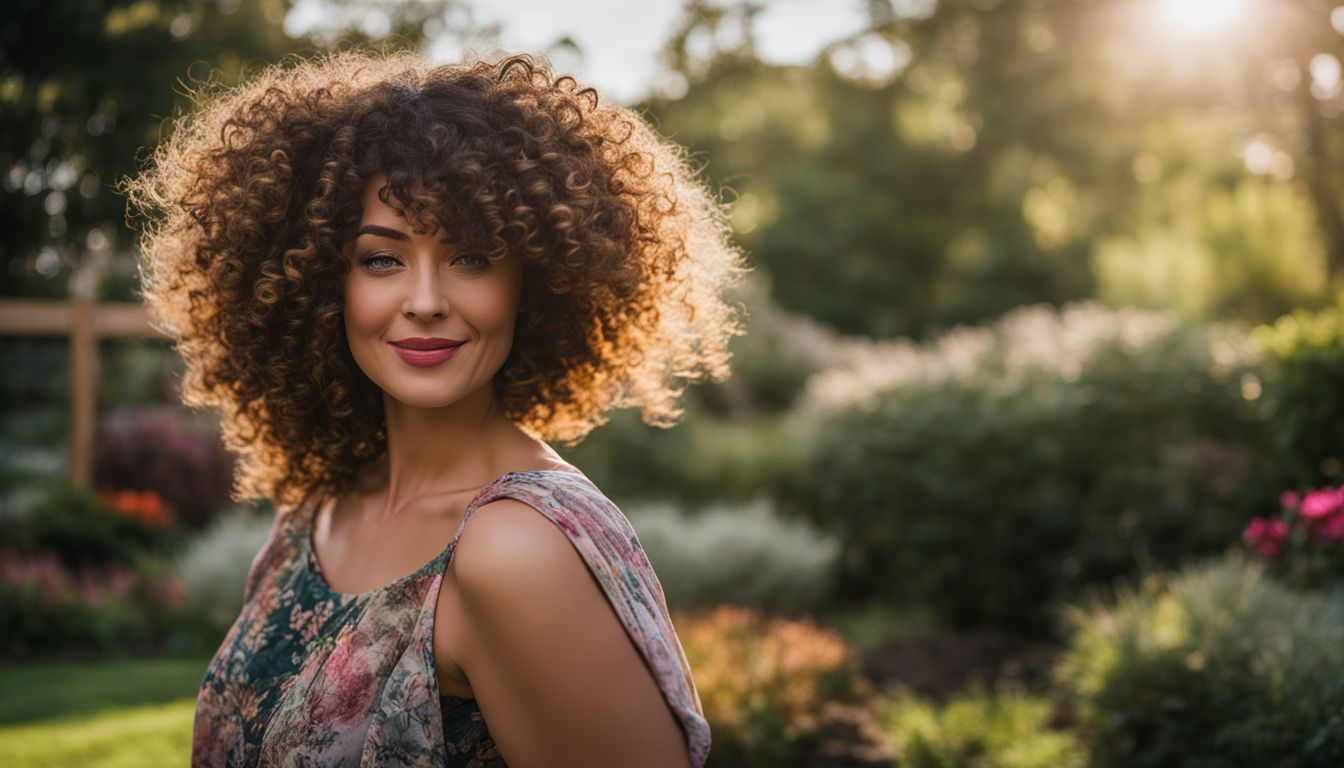
Chemo can take a toll on your hair, leaving many to wonder when those locks will return. It’s common for hair to start coming back as soft fuzz within weeks after treatment ends. In this post, we’ll explore the journey of hair regrowth after chemotherapy and provide tips to encourage fuller, healthier growth.
Keep reading to discover how you can support your scalp and reclaim your hair!
Key Takeaways
- Hair may begin to grow back as soft fuzz within 3-4 weeks after completing chemotherapy and can attain a length of about 1-2 inches in around 2-3 months.
- Regrown hair might exhibit changes in color, texture, or volume and could be curly even if one had straight hair before treatment; this phenomenon is commonly known as “chemo curls.”
- New eyelashes and eyebrows also regrow after chemotherapy, usually starting within three to six weeks post-treatment.
- Using gentle hair care products, protecting the scalp from sunlight, eating a nutritious diet, and potentially using minoxidil are ways to support healthier hair regrowth after chemo.
- While some treatments like cold caps can reduce hair loss during chemotherapy sessions, total prevention of hair loss may not be possible for most patients.
Understanding Hair Loss During Chemotherapy

Chemotherapy, hormonal therapy, targeted therapy, immunotherapy, and radiation treatment can all lead to hair loss. It’s important to understand how these treatments can affect hair growth during chemotherapy.
Chemotherapy and Hair Loss
Chemotherapy targets not only cancer cells but also other rapidly dividing cells, including the ones responsible for hair growth. As a result, many patients undergoing chemotherapy treatments notice their hair thinning or falling out, which can occur all over the body and not just on the scalp.
This side effect is common with various chemotherapy drugs, especially those known to induce alopecia.
The impact of this hair loss varies widely from person to person. Some may lose patches of hair, resulting in bald spots, while others might experience complete baldness. Cold caps and scalp cooling systems have been adopted by some cancer patients to reduce hair loss during treatment sessions.
These techniques can help preserve hairs by constricting blood vessels in the scalp, limiting the amount of chemo medicine that reaches it. Transitioning into our next topic, hormonal therapy also plays a role in changes to your mane during cancer treatments.
Hormonal Therapy and Hair Loss
Hormonal therapies are often part of the treatment for cancers like breast and prostate cancer, where hormones play a significant role in the growth and spread of cancer cells. These therapies can take a toll on your hair, and it’s not just about having a bald head or getting a short haircut.
Drugs such as tamoxifen, aromatase inhibitors like anastrozole (Arimidex), letrozole (Femara), and exemestane (Aromasin) work by lowering estrogen levels or blocking its effects, which unfortunately affects hair follicle health.
This can lead to noticeable hair loss or thinning among patients using these medications.
Patients may find their once full and vibrant locks becoming finer or experiencing bald patches as side effects of hormonal therapy. It’s not only limited to head hair; body hair can also become sparse.
Dealing with this unexpected change adds another layer to the challenge of managing life during and after cancer therapies. Unlike chemotherapy-induced alopecia, the loss from hormonal treatments doesn’t always happen right away but may gradually occur over time while on medication.
Targeted Therapy, Immunotherapy and Hair Loss
Targeted therapy for breast cancer, such as the drugs Ibrance (palbociclib) and Kisqali (ribociclib), may not always lead to full hair loss but can cause changes in hair texture or color.
Some patients experience milder forms of thinning during their treatment course. It’s important to know that while these effects can be distressing, they are often temporary and vary from person to person.
On the other hand, immunotherapy treatments like Tecentriq have been linked to hair loss in a minority of cases. Despite being less common than with traditional chemotherapy, it’s an outcome worth discussing with your doctor if you’re starting on immunotherapy.
Moving forward, another aspect needing attention is radiation therapy which plays a different role in the context of hair and its potential regrowth post-treatment.
Radiation Treatment and Hair Loss
Radiation therapy targets cancerous cells but can also lead to hair loss in the treated area. While chemotherapy often results in widespread hair loss, radiation affects only a specific part of your body.
For example, if you receive treatment for head and neck cancers, you might lose hair on your scalp, face, or neck. The severity of this side effect can vary based on the dose and duration of treatment; some people experience thinning, while others may lose their hair completely.
The impact of radiation-induced hair loss depends on several factors such as dosage and medical conditions. In certain cases, the lost locks may return post-treatment once your body recovers from the stress of fighting cancer.
However, it’s important to understand that sometimes when high doses are involved or with particular types of radiation used, hair regrowth may not be possible or could be substantially delayed compared to other forms of cancer treatments like chemotherapy.
Moving forward into managing this condition requires patience and support as one navigates through options like wigs or headwear during recovery.
Managing Hair Loss During Chemotherapy
Preventing and managing hair loss, dealing with ongoing hair thinning, and the emotional impact of hair loss are all important aspects of managing hair loss during chemotherapy. To learn more about how to navigate these challenges, keep reading!
Preventing and Managing Hair Loss
During chemotherapy, take steps to manage and minimize hair loss. Consider using cold caps or scalp cooling systems during treatment to reduce the impact on hair follicles. Additionally, explore options like wigs, scarves, hats, and turbans to help cope with potential hair loss.
- Protect your scalp from sun exposure as new hair begins to grow by using sunscreen or wearing a hat when outdoors. Utilize lotions and conditioners to alleviate any itchiness associated with regrowth.
- Discuss the potential benefits of using minoxidil with medical professionals to promote new hair growth after cancer treatment. This topical treatment for pattern baldness can be considered post-treatment for both men and women.
Dealing with Ongoing Hair Thinning
As you work on managing ongoing hair thinning, it’s important to be proactive and seek guidance from dermatologists for effective solutions. Here are some practical steps to help you deal with ongoing hair thinning:
- Consider using products like Rogaine, which have shown benefits in stimulating hair growth and reducing continued thinning after chemotherapy.
- Explore the potential benefits of nutritional supplements such as Nutrafol and Viviscal Hair Growth supplements, which may support healthy hair regrowth post-chemotherapy.
- Seek support from friends, family, mental health professionals, or join support groups to cope with the emotional impact of ongoing hair thinning and maintain a positive mindset.
- Consult with healthcare providers to evaluate any potential underlying conditions that could contribute to ongoing hair thinning and explore suitable treatment options.
- Prioritize self-care by maintaining a balanced diet, incorporating stress-reducing practices, and using nourishing hair care products to promote overall scalp health and potentially reduce ongoing hair thinning.
- Stay informed about emerging treatments or techniques that could help manage ongoing hair thinning effectively post-cancer treatment.
The Emotional Impact of Hair Loss
Dealing with ongoing hair thinning during chemotherapy can be emotionally distressing. Hair loss from cancer treatments can deeply impact self-esteem and emotional well-being, leading to feelings of vulnerability and anxiety.
The visible nature of hair loss may also reveal a person’s illness, potentially affecting their privacy and sense of control over their personal information.
The emotional impact of hair loss in the context of cancer treatment is significant and may necessitate understanding and support from medical professionals as well as the individual’s support network.
Hair Regrowth After Chemotherapy

After chemotherapy, it’s common for patients to experience hair regrowth. The timeline and appearance of new hair can vary, but there are tips to help enhance the regrowth process.
Timeline for Hair Regrowth
Hair regrowth after chemotherapy follows a gradual timeline:
- After 3 – 4 weeks, soft fuzz may start to appear on the scalp.
- Around 2-3 months, hair growth becomes noticeable, about 1-2 inches in length.
- By the 6-month mark, hair length can vary from 2-3 inches as it continues to grow.
- After approximately 12 months, hair may reach a length of 4-6 inches, exhibiting different attributes such as color, texture, or volume compared to pre-treatment hair.
What Hair Regrowth After Chemo Looks Like
After the initial regrowth, hair following chemotherapy often appears soft and fine, resembling fuzz. Over the subsequent months, it gradually thickens and gains length. The average growth rate is 0.5 inches per month, eventually reaching a length of 4-6 inches in about 12 months.
However, it’s important to note that new hair may differ in color, texture or volume from your pre-treatment hair.
In some cases of certain chemotherapy drugs like Taxotere (docetaxel), there may be incomplete regrowth or permanent baldness. Additionally, hormonal therapies can also lead to mild to moderate hair loss due to reduced estrogen levels impacting follicle growth.
Tips for Enhancing Hair Regrowth After Chemo
To enhance hair regrowth after chemo, consider these tips:
- Use gentle hair care products to avoid further damage.
- Avoid heat styling tools and harsh chemicals that can stress the hair.
- Eat a balanced diet rich in protein, vitamins, and minerals to support healthy hair growth.
- Consider using minoxidil foam or other over-the-counter treatments recommended by your healthcare provider.
- Protect your scalp from sun exposure by wearing a hat or using sunscreen.
Changes in Hair After Chemotherapy

After chemotherapy, many cancer survivors experience changes in their hair texture and color, often referred to as “chemo curls.” Additionally, regrowth of eyelashes and eyebrows can also occur after treatment.
Chemo Curls: Changes in Hair Texture
Chemotherapy can lead to a surprising change in hair texture, often resulting in what’s commonly known as “chemo curls.” New hair growth after chemotherapy may be curly, even for individuals who previously had straight hair.
This transformation occurs due to alterations in the shape of the hair follicle during the period of hair loss caused by chemotherapy, leading to an unexpected shift from straight to curly or wavy strands post-treatment.
After undergoing chemotherapy, many individuals experience variations in both the density and texture of their regrown hair. Some people find that their new post-chemo hair closely resembles their pre-treatment hair, while others notice a complete transformation in the quality and composition of their regrown locks.
Changes in Hair Color After Chemo
Hair color changes are common after chemotherapy due to the impact of cancer drugs and treatments on hair follicles. The regrown hair may have a different color, texture, or volume compared to pre-treatment.
For instance, hormonal therapy can cause mild to moderate hair loss or thinning, affecting the color and texture of regrown hair. Additionally, targeted therapy may also lead to changes in hair color once regrowth begins.
Managing these changes can involve using support from friends, family, mental health professionals, or support groups.
Eyelashes and Eyebrows Regrowth
New eyelashes and eyebrows will start to grow back after chemotherapy treatment, but the regrowth process may be slower for some individuals. Typically, new hair growth can begin to appear around three to six weeks after completing chemotherapy.
Initially, the regrown hairs may be patchy and uneven, but patience is key as they fill in over time.
For those who have completed their chemotherapy treatments, seeing new eyelashes and eyebrows emerge can bring a sense of hope and renewal. The appearance of these delicate hairs signals the body’s natural healing process at work.
Frequently Asked Questions about Hair Regrowth After Chemotherapy
Wondering about the speed of new hair growth, hair care after chemotherapy, and the use of minoxidil for hair regrowth? Find answers to these common questions and more in our frequently asked questions section.
Read on to learn more!
Speed of New Hair Growth
New hair growth typically begins around three to six weeks after completing chemotherapy treatment. The rate of regrowth varies, but on average, hair grows about half an inch per month.
It can take anywhere from three to eight months for the new hair to reach a length suitable for a short textured style. Initially, the regrowth may be patchy and uneven, with slower growth around the hairline and crown area.
As we explore what hair regrowth after chemotherapy looks like, it’s essential to understand “What Hair Regrowth After Chemo Looks Like”.
Hair Care after Chemotherapy: Coloring, Perming, and Straightening
After considering the speed of new hair growth, it is essential to be mindful of how to care for your regrown hair. Here are some tips for coloring, perming, and straightening your hair after chemotherapy:
- Coloring: Wait until your hair has fully regrown before applying any color treatment. Consult with a professional hairstylist who understands post-chemotherapy hair to choose the safest options.
- Perming: Avoid chemical perms until your hair has regained its natural strength and texture. Consider using heat-free methods like braiding or twisting to achieve natural-looking curls.
- Straightening: Limit the use of heat styling tools to prevent damage to delicate regrown hair. Opt for heat protectants and lower heat settings when using flat irons or blow dryers.
- Seek advice from a dermatologist or trichologist before making any drastic changes to your regrown hair, ensuring that the products and techniques you choose are suitable for fragile new growth.
- Be patient and gentle with your regrown hair; avoid over – processing or excessive styling that could disrupt the natural recovery process.
The Use of Minoxidil for Hair Regrowth
Minoxidil is a hair regrowth treatment that needs careful consideration and discussion with healthcare professionals before use. Waiting at least 6 months post-cancer treatment to allow for natural hair recovery before considering minoxidil is recommended.
It’s essential to understand that while minoxidil may not improve the quality of natural new hair growth after cancer treatments, it requires ongoing use to maintain any regrowth. Additionally, there are financial commitments and health considerations when using minoxidil, as the cost is around £20 per month.
Continual use of minoxidil is necessary to observe any success in maintaining new hair growth; hence, it should be treated as a long-term commitment and discussed thoroughly with an oncologist or GP beforehand to properly weigh its benefits against potential risks.
Conclusion
In conclusion, hair regrowth after chemotherapy can be a slow but hopeful process. The timeline for regrowth varies, with new hair usually starting to emerge within a few months of stopping treatment.
While the emotional impact of hair loss may be significant, many individuals find comfort in their hair gradually returning. Understanding the changes and managing expectations during this period allows for a positive outlook on one’s journey towards hair regrowth after chemotherapy.
FAQs
1. Will my hair grow back after chemotherapy for cancer like leukemia or lymphoma?
Yes, after chemotherapy treatments for cancers such as leukemia and lymphoma, your hair is likely to grow back.
2. What are some side effects of cancer treatments on my hair?
Cancer treatments like Adriamycin, Taxol, and hormonal therapies can cause loss of hair as a side effect.
3. Can anything be done to care for my scalp during treatment with anti-cancer drugs?
Using moisturizer on your scalp can help take care of it during treatment with anti-cancer drugs like Cytoxan and Doxil.
4. Why does the texture of my hair change to curly after breast cancer treatment?
After breast cancer treatments involving selective estrogen receptor modulators (SERMs) like Faslodex, some patients may find their regrown hair becomes curly due to changes at the follicle level.
5. Are there products available at pharmacies that might help with hair regrowth?
Yes, you can find over-the-counter products like biotin supplements at pharmacies which might support hair regrowth post-chemotherapy.
6. Should I consult an expert about how to manage side effects related to hair loss from chemotherapy?
Definitely! It’s a good idea to speak with dermatology professionals who have expertise in managing the causes of hair loss linked to various chemotherapies such as anthracycline drugs Ellence and Epirubicin.
